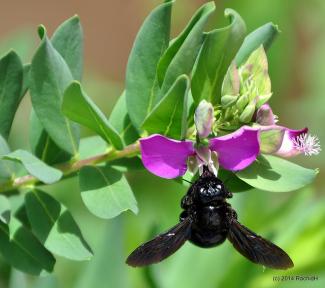
Image Credit: Rachid H
Giant Carpenter Bees (Anthophoridae: Xylocopa)
Our two native species are giants that dwarf the related bumblebee workers. They make their nests by burrowing in wood; in Oregon & California they prefer rustic picnic tables or garden kiosks. Several dozen nesting females and associated males can make a racket like a lumber mill. Like a lumber mill, they produce copious amounts of sawdust frass. Xylocopa is a tropical group which is often associated with bamboo for a nesting substrate. Though most of the females and males are shining black (with or without metallic iridescence); in some species, the males are either half white/yellow or entirely white.
In the southwestern deserts, you can find the genus Centris, which sometimes get as large as Carpenter-bees, but can be instantly recognized by their bright color patterns and hummingbird-like flight. They are typical of the American tropics, which intriguingly specializes on flowers which produce oils and waxes instead of nectar; I have watched them in Chile and Argentina harvest the oils with a spongy pad of hair on their front feet or with large spoon-like spurs (also on the front feet) for the waxes. In the southwestern US, we have very few native plants which secrete these products and the few species of native southwestern Centris have switched to a pollen with nectar diet. Some prefer the desert trees (mesquite, palo verde, desert-willow) and massive adjacent nesting sites. One species (Centris pallida) has developed the peculiar habit of producing 2 types of males: a) colorful individuals which mate in the hectic clouds of competing bees that surround the blooming trees; and b) nearly colorless giant individuals that seldom leave the immediate nest site, but dig out of their natal cells early and wait to intercept an emerging female and mate with her before she ever leaves her natal burrow.


Huge bees which make bumblebees tiny by comparison (especially some of the tropical ones throughout the world), they are almost always somewhat melanic. The eyes of the males are often larger than those of the female (in the tropics). In the PNW, the best way to attract Xylocopa is with rampant wisteria or perennial pea vines.

Though many of the bee species that nest in wood are happy to usurp some other species used burrow, Xylocopa definitely like to build their own.